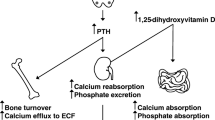Abstract
A circadian rhythm in the serum concentration of the procollagen type I carboxyl-terminal propeptide (sPICP) has previously been demonstrated in premenopausal women. This study was performed to investigate the circadian rhythm in sPICP in healthy and osteopenic postmenopausal women. Blood samples were taken every third hour for 27 h from three groups of women: 12 early postmenopausal women (aged 55±2 years; mean±SD); 12 late postmenopausal women (aged 73±1 years); and 12 osteopenic but otherwise healthy late postmenopausal women (aged 73±1 years). A circadian rhythm in sPICP was found in all three groups, as shown by cosinor analysis (p=0.000003−0.03). The circadian rhythm in sPICP was significantly different between the osteopenic group and the age-matched healthy group (p<0.008). The amplitude of the circadian rhythm in sPICP was about twice as high in the osteopenic group, and the time of the maximum tended to be about 3 h later, as compared with the age-matched healthy group. The plasma concentration of osteocalcin, as measured by a recently developed two-site enzyme-linked immunosorbent assay, also showed a circadian rhythm in all three groups (p=0.0001−0.05), with no significant differences between groups. In conclusion, we have found a significant circadian rhythm in sPICP in both early and late postmenopausal women. In osteopenic women the nightly peak in sPICP is larger and persists later into the night as compared with non-osteopenic women.
Similar content being viewed by others
References
Peltonen L, Halila R, Ryhanen L. Enzymes converting procolla-gens to collagens. J Cell Biochem 1985;28:15–21.
Prockop DJ, Kivirikko KI, Tuderman L, Guzman NA. The biosynthesis of collagen and its disorders [first of two parts]. N Engl J Med 1979;301:13–23.
Baron R. Anatomy and ultrastructure of bone. In: Favus MJ, editor. Primer on the metabolic bone diseases and disorders of mineral metabolism. 2nd ed. New York: Raven Press, 1993;3–9.
Eriksen EF, Charles P, Melsen F, Mosekilde L, Risteli L, Risteli J. Serum markers of type I collagen formation and degradation bone disease: correlation in metabolic with bone histomorpho-metry. J Bone Miner Res 1993;8:127–32.
Hassager C, Jensen LT, Johansen JS, et al. The carboxyl-terminal propeptide of type I procollagen in serum as a marker of bone formation: the effect of nandrolone decanoate and female sex hormones. Metabolism 1991;40:205–8.
Parfitt AM, Simon LS, Villanueva AR, Krane SM. Procollagen type I carboxy-terminal extension peptide in serum as a marker of collagen biosynthesis in bone: correlation with iliac bone formation rates and comparison with total alkaline phosphatase. J Bone Miner Res 1987;2:427–36.
Eastell R, Simmons PS, Colwell A, et al. Nyctohemeral changes in bone turnover assessed by serum bone Gla-protein concentration and urinary deoxypyridinoline excretion: effects of growth and aging. Cli Sci 1992;83:375–82.
Schlemmer A, Hassager C, Jensen SB, Christiansen C. Marked diurnal variation in urinary excretion of pyridinium cross-links in premenopausal women. J Clin Endocrinol Metab 1992;74:476–80.
Schlemmer A, Hassager C. Pedersen BJ, Christiansen C. Posture, age, menopause, and osteopenia do not influence the circadian variation in the urinary excretion of pyridinium crosslinks. J Bone Miner Res 1994;9:1883–8.
Nielsen HK, Brixen K, Mosekilde L. Diurnal rhythm and 24-hour integrated concentrations of serum osteocalcin in normals: influence of age, sex, season, and smoking habits. Calcif Tissue Int 1990;47:284–90.
Pietschmann P, Resch H, Woloszczuk W, Willvonseder R. A circadian rhythm of serum osteocalcin levels in postmenopausal osteoporosis. Eur J Clin Invest 1990;20:310–2.
Hassager C, Risteli J, Risteli L, Jensen SB, Christiansen C. Diurnal variation in serum markers of type I collagen synthesis and degradation in healthy premenopausal women. J Bone Miner Res 1992;7:1307–11.
Schlemmer A, Hassager C, Delmas PD, Christiansen C. Urinary excretion of pyridinium cross-links in healthy women: the long-term effects of menopause and oestrogen/progesterone therapy. Clin Endocrinol 1994;40:777–82.
Eastell R, Calvo MS, Burritt MF, Offord KP, Russell RGG, Riggs BL. Abnormalities in circadian patterns of bone resorption and renal calcium conservation in type I osteoporosis. J Clin Endocrinol Metab 1992;74:487–94.
Pedersen BJ, Bonde M. Purification of human procollagen type I carboxyl-terminal propeptide cleaved as in vivo from procollagen and used to calibrate a radioimmunoassay of the propeptide. Clin Chem 1994;40:811–6.
Committee on Enzymes of the Scandinavian Society for Clinical Chemistry and Clinical Physiology. Recommended methods for the determination of four enzymes in blood. Scand J Clin Lab Invest 1974;33:291–306.
SAS Institute. SAS/STAT guide for personal computers. 6th ed. Cary, NC: SAS Institute Inc., 1987.
Nelson W, Tong YL, Lee J-K, Halberg F. Methods for cosinor-rhythmometry. Chronobiologia 1979;6:305–23.
Smedsrød B, Melkko J, Risteli L, Risteli J. Circulating C-terminal propeptide of type I procollagen is cleared mainly via the mannose receptor in liver endothelial cells. Biochem J 1990;271:345–50.
Posen S, Grunstein HS. Turnover rate of skeletal alkaline phosphatase in humans. Clin Chem 1982;28:153–54.
Canalis E, McCarthy T, Centrella M. Growth factors and the regulation of bone remodeling. J Clin Invest 1988;81:277–81.
Canalis E, Centrella M, Burch W, McCarthy TL. Insulin-like growth factor I mediates selective anabolic effects of parathyroid hormone in bone cultures. J Clin Invest 1989;83:60–5.
Logue FC, Fraser WD, O'Reilly DS, Cameron DA, Kelly AJ, Beastall GH. The circadian rhythm of intact parathyroid hormone-(1–84): temporal correlation with prolactin secretion in normal men. J Clin Endocrinol Metab 1990;71:1556–60.
Calvo MS, Eastell R, Offord KP, Bergstralh EJ, Burritt MF. Circadian variation in ionized calcium and intact parathyroid hormone: evidence for sex differences in calcium homeostasis. J Clin Endocrinol Metab 1991;72:69–76.
Kream BE, Petersen DN, Raisz LG. Cortisol enhances the anabolic effects of insulin-like growth factor I on collagen synthesis and procollagen messenger ribonucleic acid levels in cultured 21-day fetal rat calvariae. Endocrinology 1990;126:1576–83.
Sherman B, Wysham C, Pfohl B. Age-related changes in the circadian rhythm of plasma cortisol in man. J Clin Endocrinol Metab 1985;61:439–43.
Author information
Authors and Affiliations
Rights and permissions
About this article
Cite this article
Pedersen, B.J., Schlemmer, A., Rosenquist, C. et al. Circadian rhythm in type I collagen formation in postmenopausal women with and without osteopenia. Osteoporosis Int 5, 472–477 (1995). https://doi.org/10.1007/BF01626611
Received:
Accepted:
Issue Date:
DOI: https://doi.org/10.1007/BF01626611




